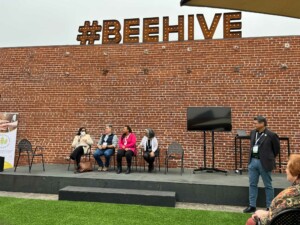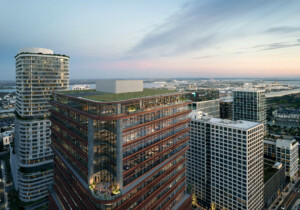In November 2019, voices from the spheres of architecture, design, political science, cybernetics, sociology, urbanism, and curatorial practice assembled in Riga. Standing alongside a delegation of over four hundred from, and fresh to, the Latvian capital, Architecture of Migration—the first international conference of its kind—sought to open a fissure within which architecture in its broadest sense could be discussed through the lens of migration.
“The world today is characterized by movement, speed, networks, connections,” declared Dina Suhanova and Dagnija Smilga. “It is a globe of constant circulation.” Against this backdrop, Suhanova and Smilga, both Riga-based architects and co-organizers of the event, advocated for their own understanding of architecture; an understanding that is quiet in its radicality. In their reading, architecture cannot be reduced to an inhabitable building. It is a system – the physical infrastructure of space, intangible connections, and a medium and prerequisite for movement. A central aim of the conference was to push recognition that architecture operates through, beyond, and without borders, that it is, and always has been, a natural process with varying social and spatial consequences.
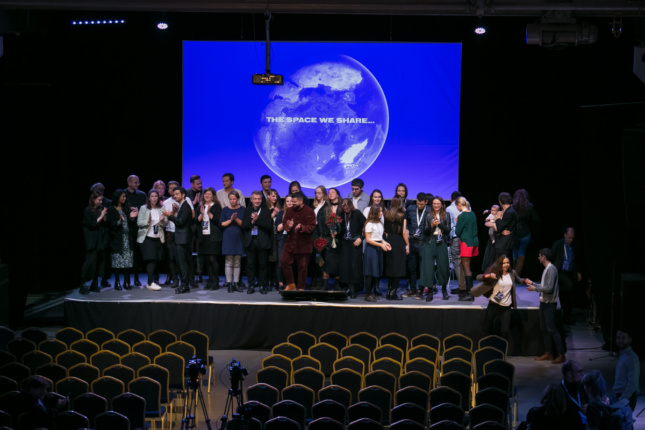
“Think of [this conference] as an exploded axonometric!” Smilga explained to the delegates. Organized around four scales: “The Nordic-Baltic region in the Crossroads of Global Mobilities”, “The Ecosystem of the Baltic Sea region: A Space Shared?”, “Beyond Intersections of Urban and Rural”, and “Current Responses to the Baltics in flux,” discussions were distilled from global concerns to regional conversations. These four chapters were bound together by a single spine: To build a platform for common understanding and to isolate opportunities between divergent actors. At the heart of this approach was a desire to seek out and identify future scenarios for the development of the “Baltic Space,” a physical and conceptual territory encompassing Estonia, Latvia, Lithuania, and the Baltic Sea.
The most evident pan-national parallels were drawn between the Nordic and Baltic regions, something not altogether unexpected given the area’s distant and recent past. Beginning formally in the 1990s, the Nordic Council (a body that fosters cooperation between Denmark, Finland, Iceland, Norway, Sweden, the Faroe Islands, Greenland, and the autonomous islands of Åland) set its sights firmly on closer collaborations with the Baltic nations. This has resulted in an influx of investment. Coupled with a diversification of populations, closer ties with the Nordics has led to a gradual identity realignment.
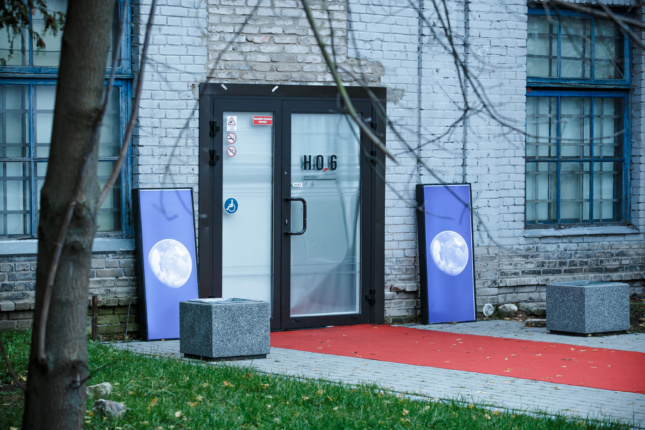
Nordic-Baltic relations go further back, however. In 2016, architects Jurga Daubaraitė and Jonas Žukauskas passed along a text written by the Lithuanian geographer and geo-politicist Kazys Pakštas. (Daubaraitė, Žukauskas, and Smilga were part of the nine-strong curatorial team that presented the first Baltic Pavilion at the 15th Biennale Architettura in Venice.) Published in English in 1944, The Baltoscandian Confederation envisioned a new supranational entity, eponymously named, comprising what we know today as Denmark, Norway, Sweden, Finland, Estonia, Latvia, Lithuania. Pakštas prefaced this prospect with an urgency masked as an observation. “We are living in turbulent, but nevertheless interesting times,” he wrote.
This decade has proved to be similarly turbulent for Europe and the region. In 2014, Russia illegally annexed Crimea and the E.U. discontinued regular bilateral summits as a result. Russia was excluded from the G8. Sanctions were initiated. For the Baltic states, each of which territorially border the Russian Federation (Lithuania does not border Russia’s western border, it does border the Kaliningrad Oblast) and stand as the easternmost flank of the European Union, recent events have heightened focus on what it means to be in the ‘East’ and what it means to be in the ‘West.’ And they are not alone. The Nordic region—Sweden, Norway, and Finland in particular—have also started to raise an eyebrow eastwards. In 2018, the Swedish government (diplomatically “neutral” and not a member of NATO) reissued a document titled If Crisis or War Comes (Om krisen eller kriget kommer), an informational pamphlet indicating that planning for the defense of the realm had been resumed after decades of demilitarisation.
Many opportunities center on the Baltic Sea, and so follows tension. The Baltic is today considered less of an aquatic ecosystem (although it is, and is rapidly approaching the status of an oceanic dead zone) and more of a pool of infrastructure, movement, and mobility. If it had come to pass, Pakštas’s Baltoscandia would have likely become a nation of significant economic and geopolitical influence. From the low-lying lands of middle Europe to the arctic territories of the far north, the federation would have encircled and controlled access to the Baltic Sea. People of different cultures and languages would have been united under one aegis to form, in Pakštas’s own words, a “zone of smaller nations of common cultural interests and mutual sympathies.” In March 2004, Estonia, Latvia, and Lithuania became members of NATO. In May of the same year, they joined the European Union and become the first and so far only former states of the Soviet Union to have joined either supranational organization.
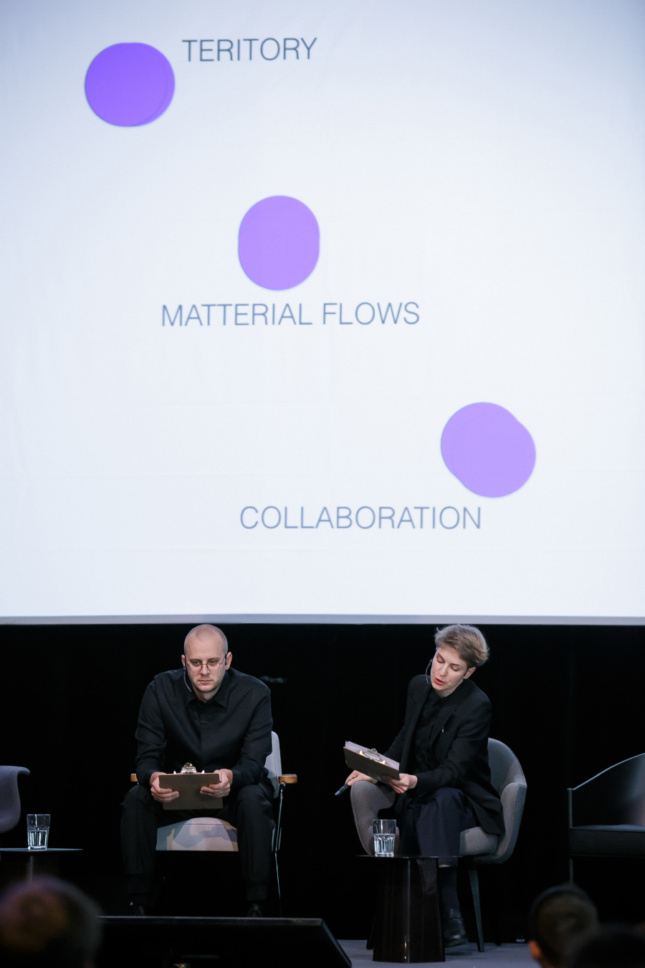
Architecture of Migration opened with a discussion on this theme: the Nordic-Baltic region as a territory at the crossroads of global mobilities. During the opening session, a conversation took place between Kirsten Ritchie (Gensler), Ieva Ilves (adviser to the President of Latvia for Information and Digital Policy), and the researcher Justinien Tribillon (cofounder of Migrant Journal, a publication that culminated with its sixth volume earlier this year). Faced with a question on the role of national identity at a moment increasingly shaped and influenced by supranational forms of governance, Tribillon said: “I’m wondering what the [nation] state of tomorrow will look like, and therefore what the identity of tomorrow will look like.”
The greater part of the conversations that took place were along similar lines. The discussion was fluid and underlying themes were often reminiscent of ideas that were put forward by the late sociologist and political philosopher Zygmunt Bauman. In 2016, in what was to be his final television interview, a conversation on Al-Jazeera centered on the mass migration and movement of people. Bauman contextualized the perceived ‘migration crisis’, as it was unhelpfully labeled at the time, as part of a crisis of fear and uncertainty. Exponential inequality, dysfunctional economies, increasing concern for the climate, the smelting of governments and institutions—their decreasing dependability, authority, and ability to follow through on their promises—have all contributed to the murky mess that we presently find ourselves wading through, he argued. With no single solution in sight, Bauman was pressed by the interviewer to contemplate a way out of the soup. His retort was simple; he advocated for empathy. “But,” he asserted, “and that is a big but, unfortunately […], there is no instant solution. Dialogue is a long, long process.”
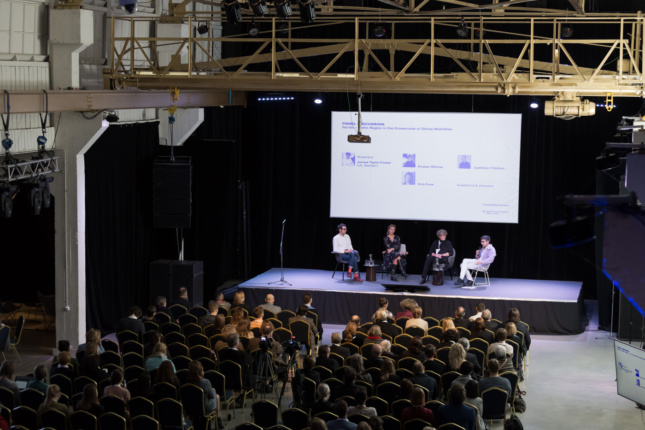
Room for dialogue on issues as urgent, muddling, and wide-reaching as migration remain as hard to find today as they were in 2016. Architecture of Migration made enormous inroads to carve out space for discourse. It was, in many ways, a show-and-tell, a presentation of case studies that oscillated around themes of borders, land, identity, and geopolitics. Alongside presentations by architect and historian Ignacio G. Galán, architect and educator Sille Pihlak (PART), architects Petras Isora and Ona Lozuraityte (AIL), urbanist Keiti Kljavin, and urban researcher Mike Emmerik (Crimson Architectural Historians), Irene Stracuzzi’s project The Legal Status of Ice articulated the diplomatic firestorm currently faced by the Arctic region. At the center of a contentious territorial dispute, Canada, Denmark, Norway, the United States, and Russia all have claims (the latter laid theirs by planting a titanium flag on the seabed 14,000 feet below the North Pole, aided by a robotic submarine).
Closer to home, Ivan Sergejev presented the Estonian town of Narva, where he is currently Chief City Architect. As one of the leading minds behind Narva’s European Capital of Culture 2024 bid, which it ultimately lost to Tartu, Sergejev took delegates through the latent potential that can be harnessed by way of conceptual projects. As Estonia’s most eastern township, only meters from the country’s border with Russia, its Russian-Estonian citizenry came together under the auspices of the bid and new life was injected into a place that, in recent years, had suffered from a post-industrial slump.
A propositional presentation by Markus Schaefer, a partner of the Zürich-based studio for architecture, strategies, and research Hosoya Schaefer, put the concept of “Deep Urbanism” onto the table. Using Switzerland as a point of reference, Schaefer described a discipline of relationships that generate a complex system of people and their culture acting on equally as complex territories. For Schaeffer, cities cannot be seen as a solution to achieve a sustainable existence. Rather, they should be considered as a form of cultural technology that, in the same way as all technologies tend towards, can have both beneficial and adverse effects. The inherent and multifaceted depth of the city—a place of interaction and transformation, plus—must be recognized and, in so doing, utilized.
Smilga and Suhanova had made clear their reasoning for the conference from the beginning. “We both believe that performing in the field of architecture is part of building surrounding culture,” they declared. Through the lens of architecture, a discipline and practice fundamentally tethered to the ways we live, work, move and belong, came an event that embraced an open-ended understanding of the topic it was seeking to address. The (perpetually) turbulent times that we are each a part of demands us to listen to one another more closely, and with more generosity. As we all move into the third decade of the new millennium, Architecture of Migration proved that space to exchange and reimagine the transforming and transformative role of architecture has a crucial role to play in the most formidable challenges—and opportunities—that we face.
James Taylor-Foster is a writer, editor, and curator working in the fields of architecture, design, e-culture, and technology. He is the curator of contemporary architecture and design at ArkDes, Sweden’s national center for architecture and design, in Stockholm. He moderated a discussion at the Architecture of Migration conference.








